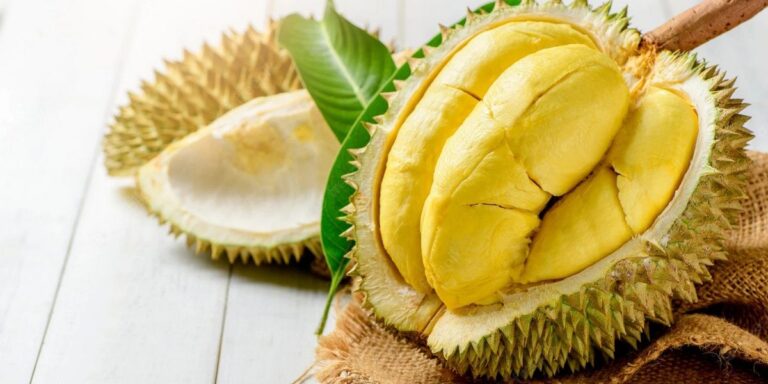Dubbed the “King of Fruits” in Southeast Asia, the Durian Fruit is as notorious as it’s far revered. Known for its ambitious spikes and stinky smell, it often elicits robust reactions—human beings either like it or hate it. This divisive fruit has captivated the hearts of many in its native regions, at the same time as others conflict to get beyond its powerful fragrance. In this newsletter, we will explore the captivating global of Durian Fruit, delving into its records, cultural significance, nutritional blessings, and culinary uses.
Origins and History
The durian fruit is local to Southeast Asia, with its origins tracing back to Malaysia, Indonesia, and Borneo. The call “durian” is derived from the Malay phrase “duri,” meaning thorn, which aptly describes the fruit’s spiky husk. Historical records indicate that the Durian Fruit has been ate up inside the region for centuries. In reality, it changed into referred to in ancient Chinese and Malay texts, highlighting its lengthy-standing presence in Southeast Asian lifestyle.
The fruit received worldwide attention during the 19th century whilst European explorers and naturalists commenced documenting their encounters with it. Alfred Russel Wallace, a British naturalist, famously defined the durian as having a “rich custard highly flavored with almonds” in his writings, sparking interest among Western audiences. Despite its arguable aroma, the Durian Fruit has gradually found its way into international markets, becoming a image of Southeast Asian way of life.
The Durian’s Infamous Odor
Perhaps the maximum notorious feature of the Durian Fruit is its smelly odor, which has been likened to the entirety from rotten onions to raw sewage. This exceptional scent is primarily because of a combination of risky sulfur compounds gift inside the fruit. The depth of the aroma varies between exceptional varieties of durian, with some being milder than others.
In many components of Asia, the durian’s scent is so overpowering that it’s far banned in lodges and public transportation. However, for folks that can get past the smell, the reward is a rich and creamy flesh with a flavor this is often defined as a complicated mix of candy and savory notes. It’s a real culinary enjoy that requires an open mind and adventurous palate.
Varieties of Durian
There are over 30 diagnosed species of Durian Fruit, but most effective a handful are cultivated for consumption. The maximum popular and widely cultivated species is Durio zibethinus, which incorporates several sorts with unique flavors and textures.
- Musang King (D197): Known for its thick, creamy texture and bittersweet flavor, Musang King is one of the maximum sought-after durian varieties. Its colourful yellow flesh and small seeds make it a favourite among Durian Fruit fans.
- D24 (Sultan): This range is characterized via its wealthy, buttery texture and mildly sweet taste. It is frequently considered a extra accessible choice for first-time durian eaters because of its much less overpowering aroma.
- Red Prawn (D175): With its reddish-orange flesh and sweet, custard-like consistency, Red Prawn is a famous desire amongst folks that choose a sweeter durian.
- XO: Named after the Chinese alcoholic beverage, this range is understood for its sturdy alcoholic aftertaste and creamy texture. It is desired by way of folks that experience a more excessive flavor profile.
Each variety gives a completely unique tasting experience, making durian a flexible fruit which could cater to a extensive range of options.
Nutritional Benefits
Beyond its divisive taste and odor, Durian Fruit is also a nutritional powerhouse. It is wealthy in critical nutrients, making it a precious addition to a balanced weight-reduction plan.
- Vitamins and Minerals: Durian is an superb supply of nutrients C and B complex (B1, B6, and B12), that are critical for retaining healthful skin, metabolism, and nerve characteristic. It additionally contains essential minerals which includes potassium, iron, and copper.
- Dietary Fiber: The fruit is high in nutritional fiber, promoting healthy digestion and assisting to prevent constipation.
- Antioxidants: Durian Fruit is full of antioxidants, which help fight oxidative strain and decrease the threat of continual illnesses.
- Healthy Fats: Unlike many different fruits, durian contains monounsaturated fats, which are beneficial for heart fitness and may assist decrease bad cholesterol levels.
Despite its health advantages, durian is likewise high in calories, so it should be consumed carefully, mainly for those watching their calorie consumption.
Cultural Significance
In Southeast Asia, the Durian Fruit holds a unique location in cultural traditions and celebrations. It is regularly featured in festivals, in which locals acquire to enjoy the fruit in a communal setting. The fruit is also utilized in conventional medicinal drug, believed to have residences that may alleviate fever and improve sexual health.
The durian’s cultural significance is further highlighted via its presence in art and literature. It has been depicted in traditional paintings, people testimonies, and modern-day media, symbolizing abundance and prosperity. In Malaysia and Singapore, durian-themed excursions and occasions entice travelers eager to revel in the fruit’s precise flavor and cultural heritage.
Culinary Uses
Durian Fruit is a versatile component that can be utilized in a variety of culinary applications. In Southeast Asia, it’s far normally eaten clean, however it may additionally be incorporated into sweet and savory dishes.
- Desserts: Durian Fruit is often used to flavor desserts which include ice cream, desserts, and pastries. Its creamy texture and precise taste make it a popular desire for growing indulgent treats.
- Savory Dishes: In some areas, durian is utilized in savory dishes like curries and sauces, adding a wealthy and complex taste to the meal.
- Snacks: Dried durian chips and candies are popular snacks in Southeast Asia, imparting a convenient manner to revel in the fruit’s flavor with out the mess and smell.
- Beverages: Durian Fruit is occasionally combined into smoothies and milkshakes, imparting a tropical twist to fresh liquids.
While durian’s strong flavor may not appeal to each person, it stays a beloved aspect in Southeast Asian delicacies, celebrated for its ability to raise dishes with its exclusive taste.
Conclusion
The Durian Fruit is a fruit that defies expectancies and challenges the senses. Its powerful aroma and precise flavor make it a polarizing culinary revel in, but for the ones inclined to embrace its quirks, the durian gives a rich and rewarding flavor journey. From its historic roots in Southeast Asia to its developing popularity round the arena, the Durian Fruit continues to captivate and intrigue fruit enthusiasts. Whether you adore it or hate it, there may be no denying that the durian is a true icon of the fruit global, deserving its name because the “King of Fruits.”


